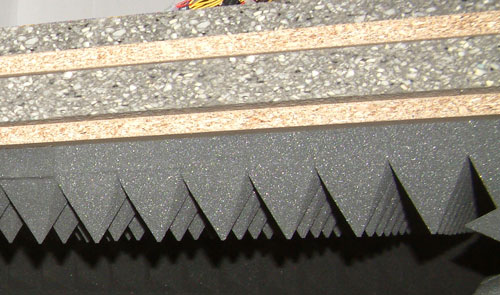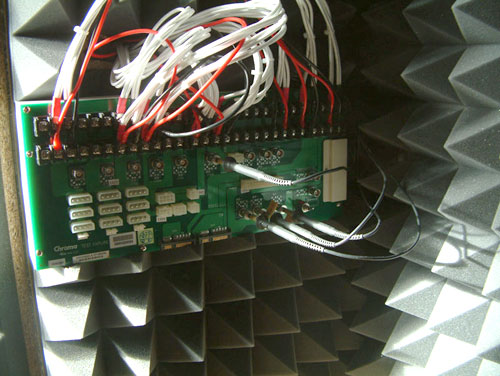Thermaltake TR2 QFan Series
by Christoph Katzer on November 19, 2008 3:00 AM EST- Posted in
- Cases/Cooling/PSUs
Testing with the Chroma ATE Programmable Load

Our test equipment consists of two Chroma programmable DC Loads that enable us to test power supplies with an output of up to 1500W. The biggest advantage of the Chroma DC Loads is simply the high precision it provides. It can measure differences as small as 0.001V and 0.0001A, which will provide us with best-in-class results.
When programming the Chroma with specific amounts of load calculated according to the ATX norm, we are able to load power supplies to an exact percentage. We can now show results at every specific percentage needed. To get the best overview of a power supply, we load each unit with 10%, 20%, 50%, 80%, 100%, and 110% of the specified output. This is easy to calculate for a 1000W power supply: the 10% load is 100W and 110% load is 1100W. Remember that this is the amount of power the PSU delivers; due to inefficiencies, a power supply will actually draw more power from the wall.
Note: If you would like to know more about our testing methodology, equipment, and environment, please read our PSU testing overview.
We have added an additional 10% on the highest load to see how the units perform with overload. This test will be performed in all future reviews. The overload test is performed at room temperature as well as under more stressful conditions; to ensure we are not too cruel to the power supplies, we will keep the ambient temperature at 50°C in the stress test. Experience shows that many units can stand the overload at room temperature but will experience problems with higher temperature and overload together. Only the best-built units will survive this.

The Testing Environment
There is one flaw in testing power supplies with programmable loads while trying to measure the sound pressure levels at the same time. Because the programmable loads get very loud, there is no chance of hearing the power supply on the test stand. In order to make accurate measurements of the noise levels we needed a way to separate the test unit and the programmable loads. Our solution was to build a very thick box around the unit.

We concluded that a five-layer box with a total thickness of 6" (15cm) containing two layers of wood and three layers of special foam would suffice. It is designed as a box within a box. The inner box does not touch any part of the outer box, making it difficult for acoustic noise to pass through in the form of vibration. Each box is isolated on both sides with a layer of heavy foam that is normally used to insulate engines. On the inside we have an additional layer of 4" (10cm) thick pyramidal foam on every side of the box to eliminate the acoustic waves coming from the test object as well as we can.

To ensure a completely closed system we installed the printed circuit board that the connectors of the power supply are attached to inside the anechoic room/box. In other box designs, you would need to put all the cables through the wall. Unfortunately, that would result in the inside of the box not being fully isolated anymore. Our design keeps everything that needs to be connected inside of the box and maintains isolation.










36 Comments
View All Comments
D3v - Monday, November 24, 2008 - link
It's nice to see a PSU review that clears up the fact that you don't need an 800-1000w PSU to run a Q6600 with a 4850 or a 9800. After I ran an 1900xtx512 setup with 'only' a 550W PSU (those cards eat power!), I just couldn't understand why anyone needed anything more.I hope they come out soon; they look fantastic, and are a step back to reality, for most of us.
Great review on a promising product. I didn't see the plus-80 stickers anywhere though.. did I miss something?
JohnMD1022 - Friday, November 21, 2008 - link
1. More reviews of 500w and under, of course.2. A push for more modular units at all levels.
3. A corresponding push for standardization of the plugs on the modular PSUs.
Number 3 is especially important... because...
If the connectors at the PSU end were standard, the cable manufacturers would make cables of varying lengths, colors, etc., just as they make USB cables, SATA, cables, etc.
It's so nice to buy 8, 10 and 12 inch SATA cables with 90 degree connectors.
Wouldn't it be great if we could get proper lengths for our PSU cables?
RagingDragon - Thursday, November 20, 2008 - link
Nice to see a review of small/moderate sized PSU's, and better yet to see you plan more of them in the future.The secondary heatsink temperature of these units look scary though, especially considering 80 degrees is very close to the 85 degree max heat rating of most inexpensive capacitors. I think I'll avoid these units for fear of exploding secondary capacitors... I'd like to see comparable results for the Seasonic 380W and 430W, the Corsair 450W and 550W units, and others in this power range - currently I'm using a Seasonic 430 and a Corsair 550, so I'd like to see how they perform relative to the competition.
Operandi - Thursday, November 20, 2008 - link
SamXon are actually very high quality caps, they rate right up and sometimes surpass the best from Japan. I wouldn't be worried about them failing.yehuda - Friday, November 21, 2008 - link
How do they compare with the secondary OST caps that Seasonic puts in its cheaper lines nowadays? I've seen them in the EarthWatt series, the CX400W [1] and the Seasonic branded OEM SS-400ET [2]. I wonder if the two Taiwanese companies are equally decent or if one has a better track record than the other.[1] http://www.pc-experience.de/wbb2/thread.php?thread...">http://www.pc-experience.de/wbb2/thread.php?thread...
[2] http://www.silentpcreview.com/forums/viewtopic.php...">http://www.silentpcreview.com/forums/viewtopic.php...
Operandi - Saturday, November 22, 2008 - link
SamXon specs out with some of the best. There was some long term testing done with also at badcaps.net and they passed that test as well with flying colors.As far as OST; I've seen them fail when placed in critical locations such as CPU VRM but they seem to fine in secondary locations and probably fine for PSU use. I know Seasonic uses (or used) them in their OEM units and they are still used in the lower wattage PCP&C Silencers which is OEM'd by Seasonic and I've never seen a failed Seasonic or PCP&C unit (I've personally used both).
yehuda - Sunday, November 23, 2008 - link
Thanks, I'll keep that in mind.Do you happen to have a link to the badcaps test? I occasionally visit their forum but I don't think I've come across it.
Operandi - Sunday, November 23, 2008 - link
The test is still going. Looks like it started in 2006, and all the caps are still holding their original ESR readings, except for the Samsung board that got killed by lighting. No surprise for the Rubycon and Panasonic but as you see the Samxon are right up there with them.I don't know how long they plan to run the test... if the Samxon are really as good as the Rubycon and Panasonics it could take awhile...
http://forums.badcaps.net/forum/showthread.php?t=2...">http://forums.badcaps.net/forum/showthread.php?t=2...
Kibbles - Wednesday, November 19, 2008 - link
I'm curious how these picoPSU fair.http://www.mini-box.com/picoPSU-120-power-kit?sc=8...">http://www.mini-box.com/picoPSU-120-power-kit?sc=8...
They seem to be just DC-DC converters but the 12v source is rated at 5amp. I don't see how they can call it a 120w kit. Still, this thing seems extremely enticing should you only need 100w for maybe a small HTPC.
They also have a 200w version on there, but the 12v source question comes into play again. If I'm calculating this right, for 200w at 100% eff, you would need 16.7amp from a 12v source.
JonnyDough - Thursday, November 20, 2008 - link
I second (third actually) the request for pico PSU reviews. We need a standard size PSU that can fit into iTX and mATX cases. I hope someone will create a standard size soon.